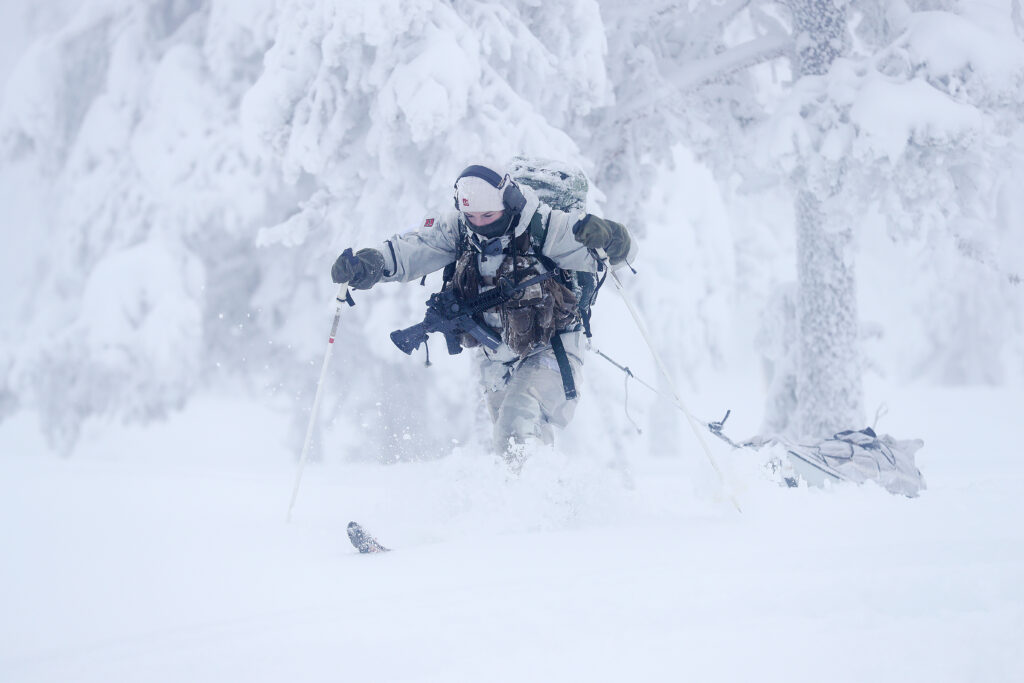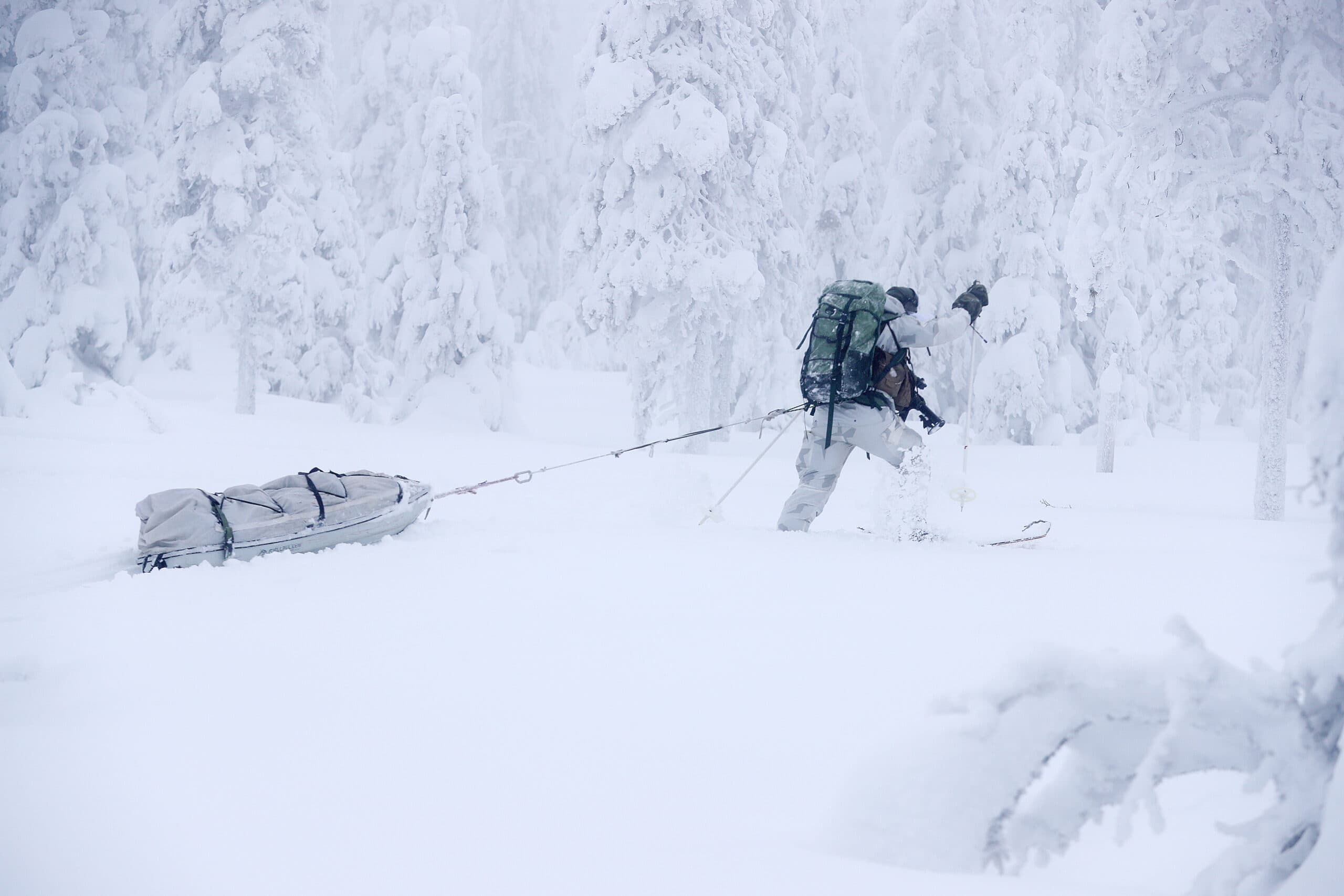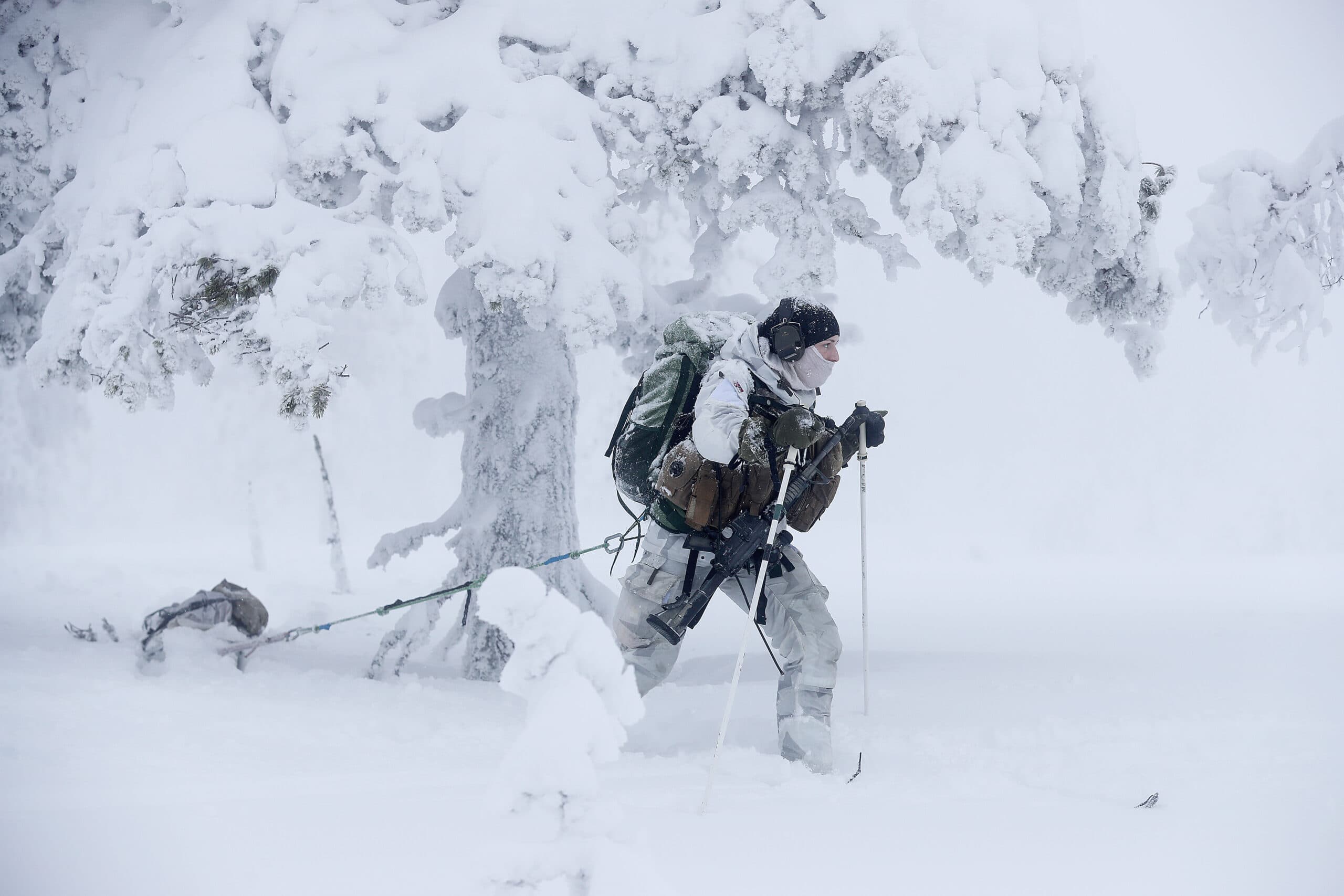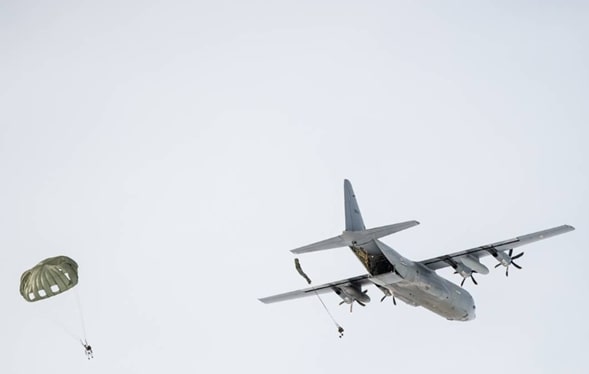1.0 Introduction: «Herregud, skal troppen ha bare jenter?»
Jegertroppen [English: Hunter’s Troop] is Norway’s all-female Special Operations Force (SOF) that specialises in surveillance and reconnaissance in urban areas. It is a subordinate unit within the Norwegian Armed Forces Special Command: the Forsvarets SpesialKommando (FSK). Jegertroppen recruits train in arctic survival skills, counter-terrorism operations, urban warfare, long-range patrolling, and hand-to-hand combat.
2.0 Patches
Recruits typically wear the Norwegian flag emblazoned on their right shoulder, accompanied with the FSK emblem.



3.0 The Norwegian Military and Women
Norwegian sovereignty has always been inseparable from the rise of the Norwegian women’s movement [source]. In 1905, a mass mobilisation of women developed to support the dissolution of Norway’s union with Sweden. Over 250,000 Norwegian women (nearly 70% of the population) submitted a petition to the Norwegian Parliament advocating for independence. By 1907, Norwegian women won the right to to vote in national elections [source]. Norwegian women’s active role in politics set a precedent that welcomed military integration in all soldiering positions much earlier than in the US and UK.
In 1964, a committee of women’s defence organisations as well as military authorities proposed introducing mandatory conscription for women both in peace and wartime. As it transpired, both the Norwegian parliament and press strongly resisted the proposal, citing the oft-made anachronistic claim that women’s military engagement would disrupt the gendered division of labour: men as breadwinners and women as housewives [source]. In 1985, the Norwegian Armed Forces allowed women entrance to all military positions on a voluntary basis [source].
3.1 Demand for Female Operative Presence
The 2001 Operation Enduring Freedom in Afghanistan exemplified the need for female operative presence amongst all-male Western military units, particularly when operating in conservative Islamic countries. Capt Ole Vidar Krogsaeter, in an interview with Foreign Affairs, stated that: “In Afghanistan, one of our biggest challenges was that we would enter houses and not be able to speak to women.” [source]. Viewed thus, all-female units can present high-value interactions and information channels previously inaccessible to male counterparts.
In 2002, when the cohort of male conscripts was considerably low, Norwegian leaders restarted discussions of parity between men and women in all positions, salaried or otherwise.
Consequently, in 2013, Norwegian policymakers introduced the selective gender-neutral conscription service in the Norwegian Armed Forces. Given the low or absent presence of women in combat roles, the commanders of the Norwegian Special Operations Commandos (NORSOC) established the pilot project Jegertroppen in a bid to recruit more women for operative military service.
4.0 Organisation
The Jegertroppen is one of the three platoons in the Training Wing at NORSOC. Beyond Jegertroppen, the Training Wing is host to the Fallskjermjegertroppen (Paratrooper Platoon) and the more advanced second-year education for SOF operators. Although Fallskjermjegertroppen permitted women entry in 1985, few have endured the rigorous selection process, and none have succeeded as of yet. Exponents in this field suggest that the creation of Jegertroppen was not only borne out of a necessity for female presence in SOF, but also affords women a training pathway with which to later join either the FSK or Marinejegerkommandoen (MJK) after their tenure [source].
Indeed, female presence in SOF is hardly a novel phenomenon, albeit scarcely available in the public domain. However, Jegertroppen not only establishes a separate education for women, but the public is actively aware of its existence.

4.1 Why Did NORSOC Choose to Separate Men and Women?
Unlike the UK, where its Special and Elite Forces have ‘one-size-fits-all’ and gender indiscriminate fitness prerequisites (and women have been successful in both), NORSOC maintains that targeted women eligible for military service should compete with each-other, rather than with their male counterparts. According to an instructor in NORSOC: “It should be self-evident that basically no women can be evaluated fairly when competing in the same selection process with the fittest men through several weeks of physical trials.” [source].
Hence, to have a conceivable chance at joining NORSOC, for instance, a potential female candidate must be an extreme statistical outlier in the women’s normal distribution to qualify for service. If successful, the potential candidate would likely become a lone woman in a male-dominated environment. Accordingly, the candidate would likely operate individually or as a member of a regular (male) SOF-team, not as a member as a female SOF-team, which was NORSOC’s argument to increase its recruiting pool of candidates [source].
4.1.1 Criticisms of Jegertroppen
NORSOC’s decision has at times received a particularly hostile reception. One common argument amongst Jegertroppen’s detractors is that women will be ill-equipped to perform alongside male counterparts in the field after conscription with Jegerstroppen as it is not conducive to reality. To this end, NORSOC emphasises that it is neither the formal standardised physical tests nor requirements that prevent women from entering Fallskjermjegertroppen, but rather the selection process itself. The selection process at NORSOC is intense, the purpose of which is to identify the best candidates in terms of collaborative skills, situational understanding, and attitude among the physically fittest applicants. NORSOC selects ‘the best’ results from their given minimum standards (usually around mark 7 on a scale to 9) from both men and women’s initial fitness tests in the selection process.
In Steder & Rones’ three-year study of the selection process at NORSOC, they found that in the top interval for endurance (usually between mark 7 and 9), only 3% of women qualify in comparison to 41% of men. For muscle strength, the share is lower, only 1% of women and 24% of men [source]. On this score, Jegertroppen is based on an operational need for women who possess military core competence for combat operations where gender matters. Not least, it also serves a pragmatic and pedagogical purpose to select, prepare, and educate women for a male-dominated arena.
4.1.2 The Operative Need for Both Men and Women’s SOF Presence Must Exist in Balance, not a Zero-Sum Equation
It is also worth mentioning that NORSCO established the Jegertroppen and Fallskjermjegertroppen for two different purposes. As Steder & Rones identified, if NORSCO selects men and women for the same platoon through different requirements, it would risk creating two different camps: an internal A-team (men) and an internal B-team (women). To reduce this risk, NORSOC established slightly different roles and functions through introducing two parallel platoons. In addition, Jegertroppen and Falksjermjegertroppen differ in specialisations. Jegertroppen must reach educational requirements of urban special reconnaissance while Falksjermjegertroppen need not. These disciplines are traditionally part of a more advanced SOF education in the following year.

4.2 Recruitment Tactics of Jegertroppen
Jegertroppen often recruit using the following means:
- Personal invitations/ letters to women with effective results from physical fitness tests
- Active posts on social media
- A three-day welcome-and-training camp
- Educational fairs and school visits

5.0 Equipment Belonging to Jegertroppen
- MO4 marching boots
- Glock P80, the Norwegian version of the Glock 17. Previously Gen 1, but it has since been upgraded to Gen 4.
- Service assault rifles: Heckler &Koch Hk416, Diemaco/ Colt Canada C8 SFW [source]. Previous assault rifles included Heckler & Koch G3, but many lamented its heaviness.
- Sniper rifles: Barrett MRAD (Circa 2015) with the calibre 338 Lapua Magnum [source].
6.0 Training of Jegertroppen
6.1 Prerequisites to Entering Jegertroppen’s Fold
Jegertroppen will evaluate a candidate’s cognitive and physical capabilities prior to (and during) their tenure. A nine-level scale measures cognitive capabilities before the conscription period starts, nine being the highest score. Jegertroppen requires higher cognitive capabilities than those at Fallskjermjegertroppen due to non-commissioned officer routes available to recruits after completion of Jegertroppen [source].
Moreover, NORSOC purposefully adapts physical requirements to women’s differences in physiology. NORSOC’s principal defence is that a significant number of men will have trained and prepared themselves for the selection from adolescence. By contrast, few women have had similar preparations, mainly due to the newly created Jegertroppen as an option within the Norwegian conscription system. On this score, NORSOC maintains that standardised physical tests for Jegertroppen must differ somewhat from Fallskjermjegertroppen. However, the latter is hotly contested seeing that women are also eligible for entrance to Fallskjermjegertroppen (and have remained so since 1985), therefore they have also had ample opportunity to train since adolescence.
For their part, NORSOC argues that the difference in preparation from adolescence by inserting a principle of progression [see fig.7]. As indicated, Jegertroppen candidates have from April to November of the typical training year to prepare for the Static Course. Conversely, Fallskjermjegertroppen candidates must pass primary selection in June, only 2-3 months preparation period compared to the Jegertroppen 5-6 month period.

6.2 Initial Selection (June)
This is a five-week recruitment period encompassing basic training in land navigation (use of a compass and map-reading), weapon education, combat technique, combat medic and physical training. In addition, it will also involve a period of self-selection wherein those who do not ‘make it’ or lose motivation withdraw voluntarily. The recruitment period culminates in ‘Hell Week,’ a testament to a candidate’s psychological and physical endurance. Not least, their ability to perform well on both an individual and team-player level.
An interview with the BBC, a former Jeger recruit revealed that Typical ‘Hell Week’ activities typically encompass long marches with little rest, and minimum amounts of food and water [source]. Recruits will also wear Norrøna Recon Pack, weighing anywhere between 40-80kg.
Even though Jeger recruits need to prove co-operation and team spirit to get through to the final exercise, it is still a competition for acceptance into the Jegertroppen. It is this segment of the selection process (before the Jegertroppen was established) that no female candidate has competed against men sufficiently to be selected for the Fallskjermjegertroppen.
In Steder & Rones’ study, they found that the average dropout between 2014-2016 was 70%. This percentage was based on relatively objective assessments, such as:
- Security clearance,
- Preliminary test results
- Standardised tests
- Medical
- Lack of interest or motivation
However, most candidates who drop out of the five-week recruitment period do so voluntarily without any special negative pressure or assisted ‘pressure’ from NORSOC.
When ‘Hell Week’ commences, at the end of the five-week recruitment period, NORSOC is left with 10-20% of the original cohort [source]. Upon successful completion, Jeger recruits reach the Opptak milestone, earning themselves the FSK patch [see fig.2] and title ‘FSK aspirant’.

6.3 Selection Process (July): Opptak
From the remaining cohorts, the instructors begin subjective assessments of the candidates. Based on evaluations as to who is best suited, as well as the candidate’s performance and rating on different tests completed during Hell Week.
Those who complete Hell Week but do not receive a place after an evaluation in the selection council, are usually negatively assessed on their collaborative skills and the relationship with fellow recruits and instructors.
The circuit training also increases with the following:
- 7km run with a 22kg Norrøna Recon Pack in MO4 marching boots and weapon.
- 1 pull-up
- 35 sit-ups in 2 minutes
- 20 push-ups
- 20 back raises
- Swim 200m (Pass or Fail)
Quite crucially, Opptak is the milestone ‘aspirant period’ during which recruits will also complete:
- Skytekurs [English: Shooting course].
- Sambandskurs [English: Communications course].
- Overlevelseksurs [English: Survival course].
- Saniteskurs [English: Field sanitation course].
Those select few must also complete a traditional examination called Hjortefot. If successful, they receive the burgundy beret, signifying their broader service with FSK [source].

6.4 The Static Course (November): Fallskjermkurs automat
The static course is understood as a transitional ritual from ‘recruit’ to ‘Jeger’ [English: Hunter]. Passing the requirements for the static course gives candidates the right to wear the distinctive parachute emblem. [See fig.10] – a revered identity symbol, ‘a quality stamp’ to attest one’s capabilities. As one might anticipate, the physical requirements for the Static Course are absolute. NORSOC has remained steadfast in its decision not to lower the requirements for wearing the ‘wing’ since Jegertroppen’s inception. Instead, NORSOC introduced the principle of progression for women and train them for the absolute requirements.

In addition to the parachute course, recruits must also complete the incremental circuit sets, including:
- 7km run with a 22kg Norrøna Recon Pack in MO4 marching boots.
- 5 pull-ups
- 35 sit-ups in 2 minutes
- 20 back raises
[source].

In the interim period between Fallskjermkurs automat and Godkjent jeger, recruits train in arctic warfare and close-combat [source]. Recruits additionally complete specialisations in close-quarters combat, driving, and urban reconnaissance.
6.5 Hunter Mark (July): Godkjent jeger
After recruits formally achieve ‘Jeger’ status in November period, there is one final circuit to complete:
- 15km run with a 22kg Norrøna Recon Pack in full fear (MO4 marching boots and weapon).
- 6 pull-ups
- 50 sit-ups in 2 minutes
- 40 push-ups
- 25 back raises
- 13-minute 2-mile run
- 400m swimming in 11 minutes (including 25m under-water).
[source].
7.0 The Future of Jegertroppen
Jegertroppen’s ongoing salience in 2023 is a testament to the value of women in SOF positions. Nevertheless, an apparent lack of career mobility from Jegertroppen directly into NORSOC roles raises questions over future retention rate.
A cursory glance of the Norwegian Armed Forces’ website reveals a difference in recruitment language behind Jegertroppen and Fallskjermjegertroppen applicants. For instance, on completion of Jegertroppen, recruits are considered: “well prepared to apply for further education in the Armed Forces”. Yet, Fallskjermjegertroppen applicants are considered: “well prepared to apply for spesjaljegertropptaket (an SOF role), which is the start of a career for operational service at FSK.” In addition, the website describes further service in NORSOC in conditional terms for Jegertroppen applicants: “when the unit has vacancies available”. Yet Fallskjermjegertroppen applicants “qualify to fill emergency positions in the department’s reserve and follow-up force” [source], [source].
It seems strange that women wishing to pursue SOF roles would do well to apply to Fallskjermjegertroppen rather than Jegertroppen in terms of career advancement and NORSOC opportunities directly available to them, especially when Jegertroppen was conceived to do the same. In Steder & Rones’ study, they postulate that possible vacancies in NORSOC that qualify from spending one year in Jegertroppen are not in the combat structure, but in the combat support or non-combat structure [source]. As a result, it suggests that the overall aim of Jegertroppen has changed since its inception. Or, silently adapted to the outcome that further career opportunities in NORSOC’s combat structure are still restrictive for women.
Unless transparent data from the NorAF reveals how many women from Jegertroppen have successfully integrated into NORSOC, it is difficult to comment on the unit’s efficacy as a pipeline for SOF progression.
8.0 Operations
At present, there is not enough evidence to corroborate Jegertroppen’s success on a large scale due to a lack of deployments abroad. Although it is readily accepted that the unit’s pedagogic nature is concerned with harnessing the skill-set of potential SOF recruits, rather than acting as an actually-existing SOF unit.
9.0 Conclusion: Jegertroppen’s Permanence?
In short, Jegertroppen is a 1-year conscription programme with the aim to encourage women to pursue SOF roles. The unit offers women a targeted training programme with which to harness their skillsets. Originally conceived as a pilot project in 2014 to be re-evaluated in 2019, its longevity is a testament to to its efficacy to encourage military core competence amongst women, even if the Norwegian military has some ways to go to offer women more comprehensive SOF progression.
This article has been rewritten and has updated information.
The original article was written by Rachele Momi (@rachele-momi)

